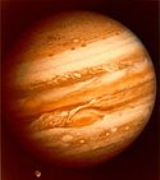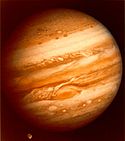
Tidal Moon
Encyclopedia
"Tidal Moon" is a science fiction
short story
by Stanley G. Weinbaum
and Helen Weinbaum that first appeared in the December 1938 issue of Thrilling Wonder Stories and was reprinted in the collection Interplanetary Odysseys (2006). Sam Moskowitz
stated that Stanley G. Weinbaum completed only a page and a half of the story before his death, and that his sister Helen Weinbaum completed the story on her own. "Tidal Moon" is the only story by Weinbaum to take place on Ganymede
.
 In Weinbaum's Solar System
In Weinbaum's Solar System
, Jupiter
radiates enough heat to create Earthlike environments on the Galilean moons
. Ganymede, the third Galilean satellite, has a subarctic climate, large bodies of water, and a six month rotation period. Due to Jupiter's tidal pull, every spot on Ganymede's surface is inundated with water every three months except a small area of the south pole where the human settlement of Hydropole is located. The Ganymedian natives, the Nympus, grow a mosslike plant called cree which is ordinarily red, but which turns blue when exposed to the ammonia in Ganymede's atmosphere. The blue moss is collected by human traders in the employ of Cree, Inc. who travel among the native villages on an aquatic riding animal called a hipp (short for Hippocampus catamiti); it is then shipped to Earth to produce crephine, a combined anesthetic and medicine. Other Ganymedian life-forms include the whale-like Gamma Rorqual, the tentacled land leet, and the four-winged Blanket Bat.
Reaching Aquia, Amherst and Scaler find that its chief trader, Carl Kent, has gone missing; his teenage daughter Carol is carrying on in his place. Kent's disappearance is ominous, since he has only recently worked out a process for distilling crephine from red moss. While Aquia is drowned in the flood, Scaler spends most of his time with Carol Kent.
A day and a half before the tide is due to ebb away from Aquia, Carol Kent discovers that her father's notes on his red moss distillation process are missing. Amherst remembers a rumor he heard that red moss has been discovered on Io
; Scaler, he realizes, must be working for Ionian Products, a company seeking to break Cree, Inc.'s crephine monopoly. If they succeed, it will mean hard times for everyone on Ganymede. Aquia is searched for Scaler, to no avail. Suddenly one of the valves leading to the surface opens; Scaler is using it to escape Aquia with Carl Kent's notes. Amherst sends Kent to get him a vacuum suit; when she returns with it, she is wearing one herself. He tells her to remain in the settlement, but she ignores his order and follows him up the aqueduct.
On the still-half-flooded surface of Ganymede, there is no sign of Scaler, but Amherst and Kent see a rocket ship in the sky, colored Ionian red. As the rocket nears the muddy ground, it lowers a ladder, then disappears behind a hill. When it reappears, there is a man clinging to the ladder. It is Scaler, and Carl Kent's process is on its way to Io.
As they return to Aquia, Carol Kent tells Amherst about her father's process, which involves exposing red moss to ammonia and treating it with an extract from the eggs of Ganymedian gall-ants. Amherst is overjoyed: Ionian Products might have the process, but they don't have the gall-ants, and gall-ants can only breed on Ganymede. Carl Kent's notes will be worthless to the Ionians.
Science fiction
Science fiction is a genre of fiction dealing with imaginary but more or less plausible content such as future settings, futuristic science and technology, space travel, aliens, and paranormal abilities...
short story
Short story
A short story is a work of fiction that is usually written in prose, often in narrative format. This format tends to be more pointed than longer works of fiction, such as novellas and novels. Short story definitions based on length differ somewhat, even among professional writers, in part because...
by Stanley G. Weinbaum
Stanley G. Weinbaum
Stanley Grauman Weinbaum was an American science fiction author. His career in science fiction was short but influential...
and Helen Weinbaum that first appeared in the December 1938 issue of Thrilling Wonder Stories and was reprinted in the collection Interplanetary Odysseys (2006). Sam Moskowitz
Sam Moskowitz
Sam Moskowitz was an early fan and organizer of interest in science fiction and, later, a writer, critic, and historian of the field.-Biography:...
stated that Stanley G. Weinbaum completed only a page and a half of the story before his death, and that his sister Helen Weinbaum completed the story on her own. "Tidal Moon" is the only story by Weinbaum to take place on Ganymede
Ganymede (moon)
Ganymede is a satellite of Jupiter and the largest moon in the Solar System. It is the seventh moon and third Galilean satellite outward from Jupiter. Completing an orbit in roughly seven days, Ganymede participates in a 1:2:4 orbital resonance with the moons Europa and Io, respectively...
.
Weinbaum's Ganymede

Solar System
The Solar System consists of the Sun and the astronomical objects gravitationally bound in orbit around it, all of which formed from the collapse of a giant molecular cloud approximately 4.6 billion years ago. The vast majority of the system's mass is in the Sun...
, Jupiter
Jupiter
Jupiter is the fifth planet from the Sun and the largest planet within the Solar System. It is a gas giant with mass one-thousandth that of the Sun but is two and a half times the mass of all the other planets in our Solar System combined. Jupiter is classified as a gas giant along with Saturn,...
radiates enough heat to create Earthlike environments on the Galilean moons
Galilean moons
The Galilean moons are the four moons of Jupiter discovered by Galileo Galilei in January 1610. They are the largest of the many moons of Jupiter and derive their names from the lovers of Zeus: Io, Europa, Ganymede and Callisto. Ganymede, Europa and Io participate in a 1:2:4 orbital resonance...
. Ganymede, the third Galilean satellite, has a subarctic climate, large bodies of water, and a six month rotation period. Due to Jupiter's tidal pull, every spot on Ganymede's surface is inundated with water every three months except a small area of the south pole where the human settlement of Hydropole is located. The Ganymedian natives, the Nympus, grow a mosslike plant called cree which is ordinarily red, but which turns blue when exposed to the ammonia in Ganymede's atmosphere. The blue moss is collected by human traders in the employ of Cree, Inc. who travel among the native villages on an aquatic riding animal called a hipp (short for Hippocampus catamiti); it is then shipped to Earth to produce crephine, a combined anesthetic and medicine. Other Ganymedian life-forms include the whale-like Gamma Rorqual, the tentacled land leet, and the four-winged Blanket Bat.
Plot summary
Ben Amherst is a cree collector on Ganymede in the year 2083. Although he normally operates alone, he finds himself accompanied on one of his rounds by a tourist from Earth named Kirt Scaler. Scaler plans to travel with Amherst to the village of Aquia, then remain there for two months while Amherst continues on his rounds. Amherst finds Scaler strangely knowledgeable about conditions on Ganymede for someone who claims never to have left Earth before.Reaching Aquia, Amherst and Scaler find that its chief trader, Carl Kent, has gone missing; his teenage daughter Carol is carrying on in his place. Kent's disappearance is ominous, since he has only recently worked out a process for distilling crephine from red moss. While Aquia is drowned in the flood, Scaler spends most of his time with Carol Kent.
A day and a half before the tide is due to ebb away from Aquia, Carol Kent discovers that her father's notes on his red moss distillation process are missing. Amherst remembers a rumor he heard that red moss has been discovered on Io
Io (moon)
Io ) is the innermost of the four Galilean moons of the planet Jupiter and, with a diameter of , the fourth-largest moon in the Solar System. It was named after the mythological character of Io, a priestess of Hera who became one of the lovers of Zeus....
; Scaler, he realizes, must be working for Ionian Products, a company seeking to break Cree, Inc.'s crephine monopoly. If they succeed, it will mean hard times for everyone on Ganymede. Aquia is searched for Scaler, to no avail. Suddenly one of the valves leading to the surface opens; Scaler is using it to escape Aquia with Carl Kent's notes. Amherst sends Kent to get him a vacuum suit; when she returns with it, she is wearing one herself. He tells her to remain in the settlement, but she ignores his order and follows him up the aqueduct.
On the still-half-flooded surface of Ganymede, there is no sign of Scaler, but Amherst and Kent see a rocket ship in the sky, colored Ionian red. As the rocket nears the muddy ground, it lowers a ladder, then disappears behind a hill. When it reappears, there is a man clinging to the ladder. It is Scaler, and Carl Kent's process is on its way to Io.
As they return to Aquia, Carol Kent tells Amherst about her father's process, which involves exposing red moss to ammonia and treating it with an extract from the eggs of Ganymedian gall-ants. Amherst is overjoyed: Ionian Products might have the process, but they don't have the gall-ants, and gall-ants can only breed on Ganymede. Carl Kent's notes will be worthless to the Ionians.

